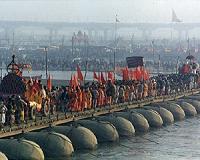| . |  |
. |
Haridwar, India (AFP) Jan 14, 2010 Millions of Hindu pilgrims readied Thursday for a ritual, pre-dawn bath in the waters of the holy Ganges river in northern India as the world's largest religious gathering gets underway. They had come from all over India: In families and couples, wealthy and poor, businessmen and farmhands, and itinerant 'sadhus' or holy men draped in saffron-coloured robes. For Hindu devotees, the three-month Kumbh Mela festival in the town of Haridwar on the banks of the Ganges, is a sacred event that offers them the chance to wash away their sins and break the karmic cycle of death and reincarnation. Even in a country where mass events are commonplace, the sheer size of the Kumbh Mela sets it apart. Several million people were set to take part Thursday on the first of four particularly auspicious bathing dates, with millions more expected to pass through the sprawling festival encampment over the next 12 weeks. The pilgrims have been arriving here for weeks, washing in the waters daily before Thursday's mass ceremony. Groups of women clustered on the final step of the "ghats" leading down to the river, unravelling their saris in the cold weather and using copper bowls to collect the water and pour it over their naked torsos. Men, stripped down to their shorts, braved a swift immersion in the icy river before rubbing themselves dry with towels. "It means a lot to us," said Manish, a 19-year-old engineering student from New Delhi. "In our religion, the Ganga is very pure and full of energy. That's why we also call the river 'Mother,'" he said, scooping up some of the water in his cupped palms which he then joined together in the gesture of Hindu prayer. Nearby, an ascetic sadhu, naked but for a black string undergarment, twisted his long, grey beard to wring out the last droplets after emerging from the clouded river. The festival commemorates a mythical battle between gods and demons over a pitcher of the nectar of immortality. During the struggle, a few drops of nectar fell in four different places: Allahabad, in the state of Uttar Pradesh, Haridwar in Uttarakhand, Ujjain in Madhya Pradesh and Nasik in Maharashtra. The Kumbh Mela alternates between these four places and takes place every three years. Once every 12 years, an even larger Maha Kumbh Mela is held. The next will be in Allahabad in 2013. The triennial festival also marks the only public gathering of hundreds of Naga sadhus, who otherwise live in relative isolation in mountains, caves and communes in the Himalayas and other regions of India. Naked and generally covered in a layer of grey ash, they are regarded by devotees as earthly representatives of the gods because of their self-sacrifice and denial of the material world. The Nagas, carrying ritual swords and tridents, will lead ceremonies on the most auspicious bathing day of all on April 14 when the Mela draws to a close. Soham Baba, considered the leader of the Nagas, told reporters recently in Kolkata that they planned to use the 2010 Kumbh Mela to highlight the issue of global warming. "Sadhus like us who go up to the higher reaches of the Himalayas to meditate have a clear picture of how bad the situation is," he said. "Pristine lakes and waterfalls that existed till a few years ago have dried up." Over the years, the festival has also become something of a tourist attraction, drawing foreigners who sometimes come to participate or simply witness the spectacle. "We can feel the emotion," said George Leonard, a retiree from Chicago who came with his wife having timed their trip to India to coincide with the Mela.
Share This Article With Planet Earth
Related Links Water News - Science, Technology and Politics
 Millions gather on the Ganges for mass Hindu festival
Millions gather on the Ganges for mass Hindu festivalDehradun, India (AFP) Jan 12, 2010 Hundreds of ash-covered, naked holy men and millions of Hindu pilgrims are making their way to northern India to take part in one of the largest religious gatherings on Earth. For Hindu devotees, the three-month Kumbh Mela, which begins Thursday in the towns of Haridwar and Rishikesh, offers the chance to wash away their sins with a ritual bath in the holy waters of the River Ganges. Eve ... read more |
|
| The content herein, unless otherwise known to be public domain, are Copyright 1995-2009 - SpaceDaily. AFP and UPI Wire Stories are copyright Agence France-Presse and United Press International. ESA Portal Reports are copyright European Space Agency. All NASA sourced material is public domain. Additional copyrights may apply in whole or part to other bona fide parties. Advertising does not imply endorsement,agreement or approval of any opinions, statements or information provided by SpaceDaily on any Web page published or hosted by SpaceDaily. Privacy Statement |